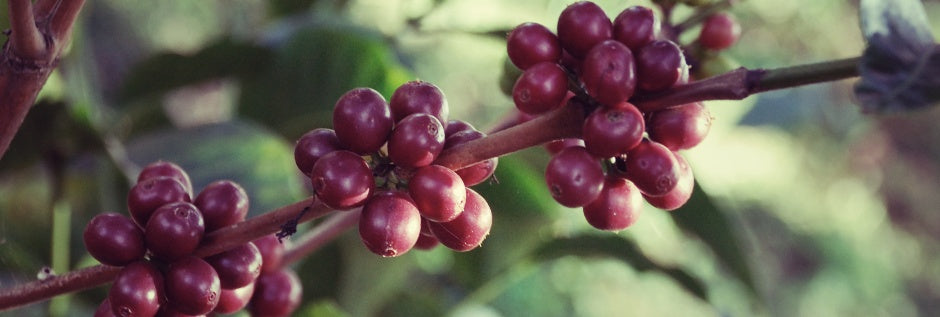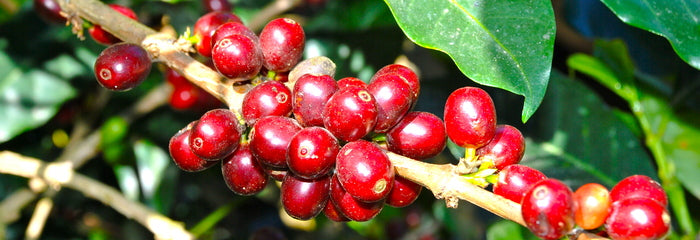Cultivars

Produced in between the tropics, with varying climates, soil, and growth processes, your cup of coffee has a specific flavor profile that can be traced to it’s region and country of origin. We call this varietal distinction. Varietals have a big impact on the cup profile of each of our single origin coffees. You will notice in our store, we list the varietal of each coffee. Varietal is a term used to describe a wine made from or belonging to a single specified variety of grape. The coffee industry has somewhat adopted this term, but instead of using it to describe a coffee of a specific variety or cultivar (i.e. Bourbon coffee), it is used in the place of the term variety or cultivar. Different cultivars will produce different size cherries/seeds.
Here is a quick list of some of the more common varietals:
 Bourbon:
Bourbon:
Complex acidity, caramel like sweetness, balance
Coffee produced from the Bourbon cultivar of the Coffea Arabica tree, was named after Bourbon Island where it was first cultivated. Bourbon Island was later renamed Reunion and is located east of Madagascar in the Indian ocean. France introduced the Bourbon cultivar to Africa and Latin America, that is why it also known as French Mission. Bourbon became the second most commercialized Arabica variety after Typica. Both the Typica and Bourbon varieties of Arabica are produced in large quantities throughout the world, but are slowly being replaced by more productive and disease resistant varieties such as Caturra. Although yielding more coffee cherry than Typica, Bourbon is still considered to be very low yielding. The bean size of Bourbon is on the smaller end of the scale while its leaves are broad and verdantly green. Bourbon cherry can mature into red, yellow and orange colors depending on the particular varietal. This coffee seed is known for its complex acidity and tremendous balance.
Caturra:
Citric and mild sweetness
Caturra is an Arabica cultivar discovered as a natural mutation of Bourbon. The main differences are Caturra is high yielding and the size of the Caturra trees does not reach the same heights making it a dwarf varietal. Because the Caturra tree is not ideal for Brazil growing conditions, it is now more common to Colombia, Nicaragua, and Costa Rica. Cup quality typically includes bright citric acidity, and less body and sweetness than Bourbon.
<

Ethiopian Heirloom:
Fruity floral, wine like
Ethiopian coffee varietals are arguably the most distinctive and best tasting coffees in the world. Over 1000 heirloom varietals are currently in production. The trees most resemble the Typica varietals that are indigenous to Yemen. The trees were eventually brought to Latin America and are believed to be the first varietal grown in the Americas. Ethiopia Heirloom varietals produce some of the most coveted flavors in the world that, depending on process. Dry process coffee are usually medium-bodied with acidic, fruity/ winy tones. Wet process coffee is light-bodied but has complex floral and citrus tones.
Gesha:
Sweet, citrus, fruit tones
Gesha is an extremely rare coffee that originated in Ethiopia. The trees grow in a very high elevation, tend to be very tall (up to 15 ft) and have beautiful, elongated seeds and leaves. In 1998, there were extreme rains that brought a plague of fungus across the coffee farms in Panama. One of the coffee farmers in the region, named Peterson was able to salvage a few varietals, one of which being the Gesha tree. The reason that the coffee is so rare is because the character of the flavor changes drastically when planted in a different area, therefore to maintain its original brilliance it is grown on the original hillside. Gesha is a buoyant coffee and has a clean sweet, fruity flavor. A very distinct bergamot-like finish is also typical in the cup profile.
Pacamara:
Citric, floral
Pacamara is a hybrid seed varietal of the Pacas and Maragogype seed strains originated in El Salvador and primarily grows there. Bean size of this varietal is very large, like its Maragogype predecessor. When grown at higher elevations, Pacamara tends to exhibit better cup quality. The flavor profile can demonstrate sweet citric notes, chocolate and floral attributes.
 SL28/Sl34:
SL28/Sl34:
Intesnsely citric and fruity, very complex
A very treaured cup! A hybrid of Bourbon and heirloom Ethiopian varietals developed by the Scottish Labs (during colonial years) which did lots work on varietals in the 1930′s. Very typical of Kenya where it was introduced although there have been lots of experimental plantings in central South Amercia, by those wanting to experiment.
 Typica:
Typica:
Clean, full body, sweet flavor
Typica is the base from which many coffee varietals are developed. The coffee trees have a conical shape with a main vertical trunk and secondary verticals that grow at a slight slant, copper colored leaves, and an extended, oval-shaped bean size. Typica coffee has a very low production, but has an excellent cup quality. Coffee Arabica Typica was the first varietal of the species discovered in the Kaffa Rainforest in Ethiopia centuries ago. A French Naval officer brought Typica tree seeds to the Americas in the 1700′s.

 Bourbon:
Bourbon: 


 SL28/Sl34:
SL28/Sl34: Typica:
Typica: